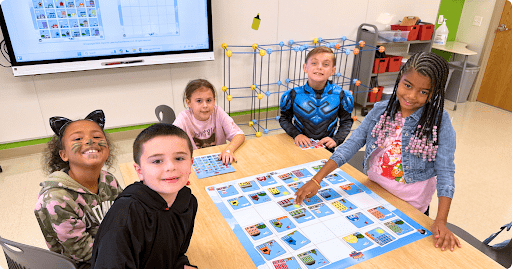Creating an engaging and effective after-school STEM program for young children can be an incredibly rewarding endeavor, not just for students but also for teachers who want to inspire curiosity and excitement in STEM (Science, Technology, Engineering, and Mathematics) from an early age. When crafted thoughtfully, a STEM program for grades K-3 can provide young learners with hands-on, engaging experiences that encourage exploration, critical thinking, and collaboration.
At Drone Legends, we specialize in helping educators bring these concepts to life with turnkey programs like Little Legends—a story-driven, play-based STEM curriculum designed specifically for young learners. If you’re a teacher interested in creating or enhancing an after-school STEM program, here’s a comprehensive guide to help you get started!
Step 1: Define Your Program Goals
The first step in creating a successful STEM program is defining clear, age-appropriate goals that align with the developmental needs of K-3 students. This age group thrives in hands-on, sensory-rich environments, where learning is presented as fun and engaging. Goals for this age group should emphasize:
- Curiosity and Exploration: Foster a sense of wonder in STEM fields by encouraging kids to ask questions, experiment, and explore.
- Teamwork and Collaboration: Include activities that require students to work together, share ideas, and solve problems collectively.
- Building Foundational STEM Skills: Use activities that develop fine motor skills, pattern recognition, and basic concepts in science, technology, engineering, and math.
Example Goal Statement: “Introduce foundational STEM concepts through story-driven, hands-on activities that encourage curiosity and teamwork, laying the groundwork for future learning in a playful environment.”
Step 2: Structure the Program for Consistency and Engagement
For K-3 students, consistency is key to maintaining interest and ensuring gradual skill-building. Plan a structured schedule that incorporates predictable elements while allowing flexibility for creativity. Here’s an example of a weekly structure:
- Week 1: Introduce the program theme, such as “Exploring the World of Drones” or “Adventures in Engineering.”
- Week 2-4: Rotate through activities that touch on different STEM areas, from unplugged coding to prompt engineering.
- Week 5: Culminate with a showcase where students can demonstrate what they’ve learned to parents and other students.
Tip: Look for programs like Little Legends which are designed with turnkey story-driven lessons and themed challenges that easily fit into a structured, engaging schedule, making it simple for educators to adapt each lesson to weekly objectives.
Step 3: Choose Age-Appropriate, Hands-On Activities
Young children are highly tactile learners, so focus on activities that allow them to manipulate materials, work in teams, and learn through play. Little Legends offers story-based adventures that incorporate hands-on activities without screens, making STEM concepts accessible and exciting for K-3 learners. Here are a few ideas inspired by the Little Legends approach:
- Science: Create a “weather station” where students learn about cloud formation, temperature, and wind by observing real-life weather patterns and charting them over time.
- Engineering: Guide students in building a simple shelter for “Gimbal,” the AI drone character, to protect it from imaginary weather elements. They can test the structure’s durability using lightweight materials like cardboard or straws.
- Math: Use physical objects to create patterns and counting games, helping students grasp basic counting and sorting concepts in a fun, interactive way.
These activities foster engagement and encourage students to think creatively, ask questions, and practice problem-solving—all essential skills in STEM.
Step 4: Pitch the Program to Decision-Makers
Pitching your after-school STEM program to school administrators or other decision-makers is an essential step, especially if you need additional funding or support. Drone Legends offers a customizable Program Proposal Guide to help you prepare a persuasive pitch. Here’s what’s included:
- Quick Talking Points: Essential information about Little Legends and the benefits of play-based, story-driven STEM learning for young students.
- Ready-Made Emails and Letters: Templates to help you communicate the program’s value with administrators and parents.
- Comprehensive FAQ: Answers to common questions about program logistics, content, and outcomes.
- Educator Testimonials: Share success stories from other teachers who’ve implemented Little Legends successfully.
- Canva Proposal Template: A visually appealing, customizable template to create a professional proposal.
- Resource Links and Free Grant Writer Access: Resources to support funding requests or grant applications, making it easier to access financial support.
Interested in getting the guide? Just email us at info@dronelegends.com and we’ll send you the link!
Step 5: Secure Funding and Support
STEM programs often require materials, resources, and additional staff time, which can require additional funding. To help with this, Drone Legends offers free access to our AI grant writer that can help you write personalized grant applications.
Some tips for applying for grants or seeking funding:
- Emphasize Program Outcomes: Focus on the educational benefits, such as improved STEM literacy and social skills.
- Highlight Unique Aspects: Mention how the program incorporates narrative-based learning, a unique approach that sets it apart.
- Utilize Testimonial Data: Share quotes or feedback from students, parents, and educators who have seen the program’s impact.
Inspire a New Generation of STEM Enthusiasts
Creating an after-school STEM program for young children is an investment in their future, encouraging curiosity, problem-solving, and a love for discovery. By structuring your program thoughtfully, you can offer students a truly engaging experience that sets the foundation for lifelong learning.
Ready to bring an innovative STEM program to your school? Explore Little Legends to see how this customizable, screen-free program can transform after-school learning for K-3 students. And if you need support with pitching your program, remember that our Program Proposal Guide has all the tools you need to present your case with confidence.
Let’s inspire young learners to explore, build, and dream big with STEM!




